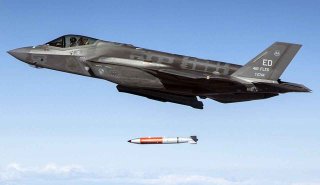The Department of Energy Just Completed Life Extension on a Key Nuclear Weapon
The B61 has already been in service for more than five decades, yet remains both "the oldest and most versatile weapon in the enduring U.S. nuclear weapon stockpile."
Even one of the greatest weapons of mass destruction has what could be described as a "shelf life." On Tuesday, the United States Department of Energy announced that its National Nuclear Security Administration (NNSA) had completed a program to keep the B61-12 nuclear bomb in service for decades to come.
The B61-12 Life Extension Program (LEP) was initiated in 2008, with a specific focus on upgrading the family of B61 gravity bombs, "which are deployed from U.S. Air Force and North Atlantic Treaty (NATO) bases." The latest modification of the original bomb, the B61-12 is a twelve-foot-long, approximately 825-pound, air-launched nuclear gravity bomb that utilizes an inertial navigation system (INS) to make a precision strike on a target.
According to NNSA, the B61 has already been in service for more than five decades, yet remains both "the oldest and most versatile weapon in the enduring U.S. nuclear weapon stockpile." The B61-12 LEP is meant to further extend the service life of the bomb stockpile by at least another 20 years. That will include refurbishing, reusing, and if necessary even replacing some of the nuclear and non-nuclear components.
As a result, instead of entirely fresh ordnance, the B6-12s are a combination of new and refurbished components from earlier variants including the B61-3, B61-4, B61-7, and B61-10. On December 18, 2024, NNSA completed the Last Production Unit (LPU) of the B61-12 LEP – the culmination of an effort that began almost 20 years earlier.
"Completing the B61-12 on schedule is the latest example of what we've been saying for several years now: NNSA is delivering capabilities at the pace and scale needed by our Department of Defense partners and our deterrence requirements," said Under Secretary of Energy for Nuclear Security and NNSA Administrator Jill Hruby.
The total cost of the program was reported to be approximately $9 billion.
Upgrades to Continue
The B61-12 LPU came three years after the First Production Unit (FPU) was achieved in November 2021, and 17 years after its design and development was first initiated.
"NNSA's program managers and experts from Los Alamos National Laboratory, Sandia National Laboratories, the Pantex Plant, the Savanah River Site, the Y-12 National Security Complex, and the Kansas City National Security Campus worked in close collaboration with NNSA on the design, development, qualification, and component production," the Department of Energy explained.
"Completion of the last B61-12 testifies to the successful collaboration we've had with our U.S. Air Force and Department of Defense partners. The momentum built through B61-12 production and delivery will continue into delivery on the other six active weapons modernization programs and on additional programs that will become active in the coming years," explained Dr. Marvin Adams, deputy administrator for Defense Programs at the DoE. "Achieving LPU in FY 2025 demonstrates our ability to execute, not only to our partners and stakeholders in DoD and Congress but also to our adversaries and allies. This demonstration is itself a contribution to deterrence and assurance."
Even as the B61-12 LEP has reached its end, NNSA will look to the B61-13, which will further build on this last upgrade effort. It is scheduled to reach its FPU in the department's fiscal year 2026 (FY26).
An Air-Launched Nuclear Weapon
The B61-12was first integrated with the U.S. Air Force's F-15E Strike Eagle, where it is carried externally, and the weapon is also being certified to be carried on the Air Force's B-2 Spirit strategic bomber, as well as the F-16C/D fighter.
Last March, the F-35 Joint Program Office (JPO) confirmed that the Lockheed Martin F-35A Lightning II achieved its nuclear certification to carry the gravity bomb in October 2023, becoming the first fifth-generation nuclear-capable aircraft. With that certification, the conventional takeoff and landing (CTOL) variant stealth fighter further became a "dual-capable" aircraft able to carry both conventional and nuclear weapons internally.
However, it was noted at the time that the F-35A can only carry the upgraded B61-12 variant – but that is essentially a moot point now that the program has reached its LPU. In addition, the certification did not extend to the stealth jet's sister variants, the short takeoff and vertical landing (STOVL) F-35B and carrier-launched F-35C. It remains unclear if and when those variants could receive the certification – and as the F-35A can carry the current variant, it is expected it will be certified for the B61-13 as it enters service.
Author Experience and Expertise: Peter Suciu
Peter Suciu is a Michigan-based writer. He has contributed to more than four dozen magazines, newspapers, and websites with over 3,200 published pieces over a twenty-year career in journalism. He regularly writes about military hardware, firearms history, cybersecurity, politics, and international affairs. Peter is also a Contributing Writer for Forbes and Clearance Jobs. You can follow him on Twitter: @PeterSuciu. You can email the author: [email protected].
Image Credit: Creative Commons and/or Shutterstock.

